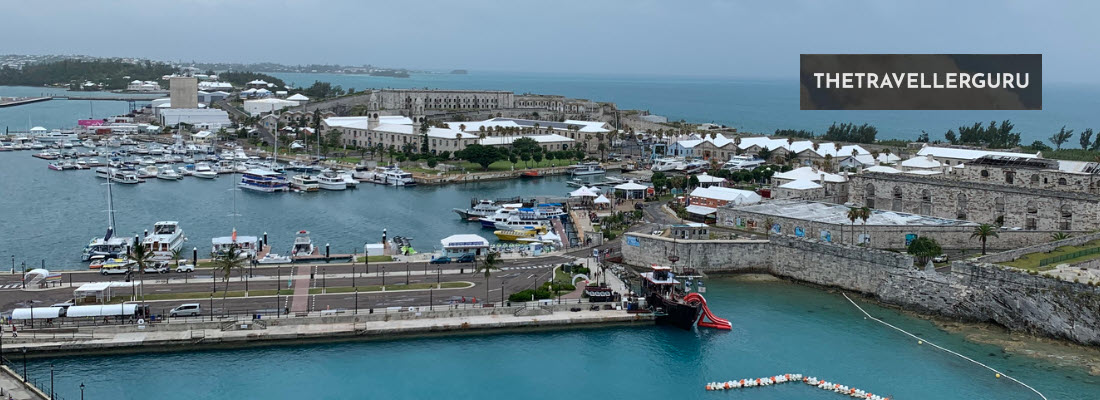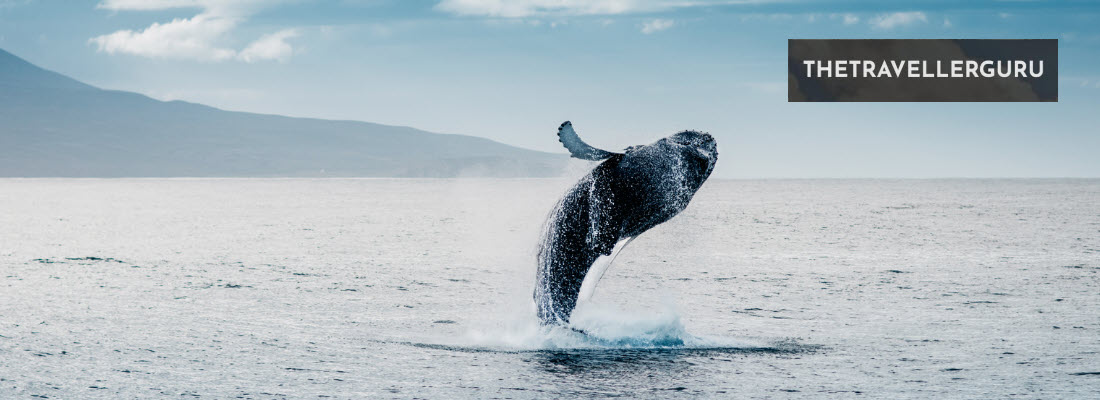Hey there my fellow travel enthusiasts and welcome to my post where we will check out my 12 best places to scuba dive in Florida this year. Florida offers a multitude of underwater treasures for scuba divers, presenting a variety of underwater ecosystems that cater to both novice and experienced enthusiasts.
The clear, warm waters surrounding Florida serve as the perfect backdrop for exploring vibrant coral reefs, the haunting beauty of shipwrecks and the allure of marine life ranging from gentle manatees to the elusive schools of colorful fish. And with its extensive coastline, myriad of artificial reefs, and vast array of natural underwater formations, this state is often considered a premier destination for scuba diving.
- John Pennekamp Coral Reef State Park
- Molasses Reef
- Blue Heron Bridge
- Dry Tortugas National Park
- The Spiegel Grove Wreck
- Fort Jefferson Wrecks
- The Cayman Salvager Wreck
- Eagle’s Nest Sinkhole
- Vortex Springs
- Ginnie Springs
- Devil’s Den
- Blue Grotto
Map of The Best Scuba Diving Spots in Florida
Use the map below to find the locations of Florida’s best dive sites as listed in the post.
Best Places to Scuba Dive in Florida
As above, Florida is renowned for its exceptional scuba diving sites, each offering crystal-clear waters, vibrant coral reefs, historic shipwrecks and marine biodiversity that draw divers from around the world. Let’s check out the 10 best and most popular options below:
1. John Pennekamp Coral Reef State Park
John Pennekamp Coral Reef State Park, located in Key Largo, is a true underwater treasure and a must-visit destination for scuba divers. Established in 1963, it was the first undersea park in the United States encompassing approximately 70 nautical square miles of Atlantic Ocean waters.
The park is famed for its vibrant and diverse coral reefs, which are part of the Florida Reef, the only living coral barrier reef in the continental United States. It offers an exceptional underwater experience, attracting divers from all over the world to explore its stunning marine ecosystem.
Outline for Scuba Divers:
Access to the Park:
- Location: Key Largo, Florida.
- Entry: Accessible by boat, with numerous charter services available from within the park.
- Facilities: The park offers a visitor center, aquarium, picnic areas, and camping facilities. The dive shop provides equipment rentals, air fills and guided tour services.
Diving Conditions:
- Visibility: Generally good, ranging from 30 to 50 feet, depending on weather conditions.
- Water Temperature: Varies seasonally, averaging 70-80 degrees Fahrenheit.
- Dive Sites: Numerous sites suitable for divers of all levels, including shallow reefs and deeper wrecks.
- Depth: Ranges from shallow snorkel areas to deeper dive sites, accommodating both novice and experienced divers.
Marine Life and Features:
- Coral Species: Over 70 species of coral, creating a vibrant underwater landscape.
- Fish and Marine Creatures: Home to more than 250 species of tropical fish, along with sea turtles, lobsters and occasional sightings of dolphins.
- Underwater Attractions: Features the famous Christ of the Abyss statue, located in shallow waters, perfect for photography.
- Wrecks and Artificial Reefs: Several sunken ships and structures have been placed in the park, serving as artificial reefs teeming with marine life.
Safety and Environmental Awareness:
- Dive Certification: All divers must be certified and proof of certification is required.
- Guided Tours: Available for those unfamiliar with the area or seeking a guided experience.
- Conservation Efforts: The park emphasizes the importance of conserving the delicate coral reef ecosystem. Divers are advised to avoid touching or standing on the coral.
Additional Activities:
- Snorkeling: The park also offers excellent snorkeling opportunities in shallower areas.
- Educational Programs: Visitor center and aquarium provide educational insights into the local marine ecosystem.
John Pennekamp Coral Reef State Park provides for an immersive experience into a vibrant underwater world. Its combination of clear waters, abundant marine life and the mesmerizing beauty of the coral reefs offer an unparalleled diving adventure, making it a top choice for divers seeking to explore the wonders of the Florida Reef.
Check out these: Best Spots in Florida for Snorkeling
2. Molasses Reef
Molasses Reef, located in the Florida Keys, is a renowned scuba diving destination known for its exceptional beauty and abundant marine life. This vibrant coral reef is part of the Florida Reef Tract, the third-largest barrier reef system in the world.
Molasses Reef is particularly famous for its clear waters, rich biodiversity and fascinating underwater structures, including a sunken ship and historical artifacts. It’s a magnet for divers and snorkelers alike, offering a glimpse into a thriving underwater ecosystem where colorful coral formations and a diverse range of marine species coexist.
Outline for Scuba Divers:
Access to Molasses Reef:
- Location: Near Key Largo in the Florida Keys.
- Entry: Primarily accessed by boat. Numerous dive operators in Key Largo offer trips to the reef.
- Facilities: Whilst the reef itself is remote, Key Largo provides dive shops for equipment rental, air fills and other amenities.
Diving Conditions:
- Visibility: Excellent, often exceeding 50 feet, making it ideal for underwater photography and exploration.
- Water Temperature: Ranges from 70 to 85 degrees Fahrenheit throughout the year, comfortable for most divers.
- Dive Types: Suitable for both beginners and experienced divers, with varying depths and conditions.
- Depth: The reef has a range of depths, from shallow areas perfect for snorkeling to deeper sections for advanced diving.
Marine Life and Features:
- Coral Species: Home to a wide variety of hard and soft corals, creating a vibrant underwater landscape.
- Fish and Marine Creatures: Abundant marine life including parrotfish, angelfish, barracudas, moray eels and occasional nurse sharks.
- Underwater Attractions: Features include the Molasses Reef Wall, sunken ship remnants and 19th-century cannons offering a blend of natural and historical exploration.
- Conservation Status: Part of a protected area, with efforts to preserve the delicate coral ecosystem.
Safety and Environmental Awareness:
- Dive Certification: Divers should be certified, and those exploring deeper sections should have advanced training.
- Buddy System: Recommended for safety, especially in deeper or more challenging parts of the reef.
- Preservation: Divers are encouraged to respect the reef by not touching or standing on the coral and being mindful of their buoyancy to avoid damaging the fragile ecosystem.
Additional Activities:
- Snorkeling: The shallower areas of the reef are also popular for snorkeling.
- Photography Opportunities: The clarity of the water and the abundance of marine life make Molasses Reef an excellent location for underwater photography.
Molasses Reef offers a spectacular diving experience with its crystal-clear waters, diverse marine life and intriguing underwater features. It’s a destination that appeals to a wide range of divers from those seeking a serene snorkeling experience to advanced divers exploring the deeper mysteries of the reef alike.
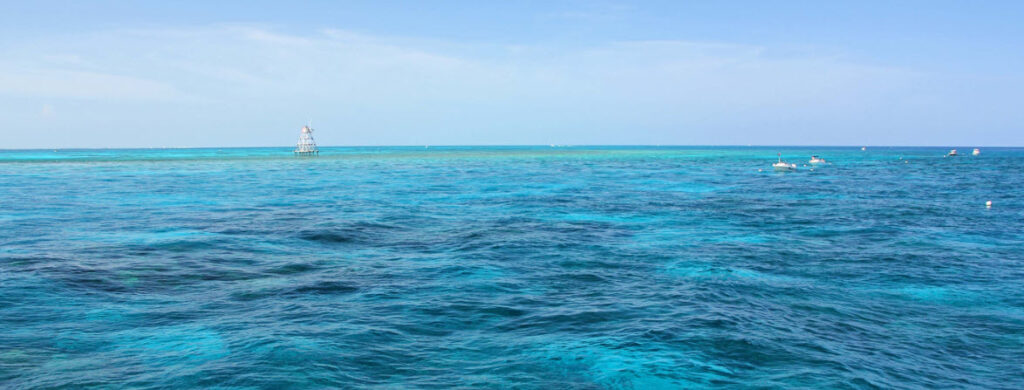
Check out these: 3 Best Travel Bags for Scuba Gear
3. Blue Heron Bridge
Blue Heron Bridge in Riviera Beach is widely regarded as one of the best shore diving locations in the United States. Situated in the Lake Worth Lagoon, this dive site is celebrated for its easy accessibility and the extraordinary diversity of marine life in relatively shallow waters.
The bridge and its surrounding areas create a unique underwater habitat that supports a wide array of creatures, making it a favorite spot for both novice and experienced divers, as well as underwater photographers. The combination of easy entry, calm conditions and an abundance of marine life makes Blue Heron Bridge a must-visit location for anyone interested in exploring the underwater world.
Outline for Scuba Divers:
Access to Blue Heron Bridge:
- Location: Riviera Beach, near West Palm Beach in Florida.
- Entry: Shore entry, with parking available at Phil Foster Park.
- Facilities: Restrooms, showers and picnic areas are available at Phil Foster Park. Nearby dive shops offer equipment rentals and air fills.
Diving Conditions:
- Visibility: Generally good, but can vary; best during high tide.
- Water Temperature: Averages between 70-85 degrees Fahrenheit throughout the year.
- Dive Types: Ideal for shore diving, snorkeling and night dives.
- Depth: Mostly shallow, ranging from 5 to 25 feet, making it suitable for beginners and snorkelers.
Marine Life and Features:
- Biodiversity: Home to an incredible variety of marine life, including octopuses, seahorses, starfish and numerous species of tropical fish.
- Unique Sightings: Known for rare and unusual marine creatures like flying gurnards, frogfish and batfish.
- Underwater Landscape: Features an artificial reef, including structures under the bridge that provide habitat for marine life.
- Photography Opportunities: The diversity of marine life and good visibility make it an excellent spot for underwater photography.
Safety and Regulations:
- Dive Planning: Best to dive during slack tide for optimal conditions. Check tide charts before planning a dive.
- Environmental Awareness: As with all dive sites, it’s important to respect the marine environment and avoid disturbing the wildlife.
Additional Activities:
- Snorkeling: The shallow waters are also perfect for snorkeling, offering close encounters with marine life.
- Community Events: The site is popular for organized dive events and underwater cleanups.
With its shallow waters hosting an astonishing variety of marine life, Blue Heron Bridge offers a unique and accessible diving experience making it the perfect site for divers and snorkelers of all skill levels to explore and enjoy the underwater world. The abundance of rare and unusual species also makes it a haven for underwater photographers and marine life enthusiasts as well.
Book your trip to Florida here!
4. Dry Tortugas National Park
Dry Tortugas National Park, located about 70 miles west of Key West, Florida, is a remote and enchanting destination that offers some of the most spectacular and undisturbed scuba diving experiences in the United States. The park comprises seven small islands and is renowned for its crystal-clear waters, vibrant coral reefs and a wealth of historical intrigue, including the famous 19th-century Fort Jefferson.
This isolated location, accessible only by boat or seaplane, is a haven for a diverse array of marine life and offers a truly unique diving experience away from the more crowded spots in the Florida Keys.
Outline for Scuba Divers:
Access to Dry Tortugas National Park:
- Location: Approximately 70 miles west of Key West.
- Entry: Accessible by ferry, private boat or seaplane. The ferry and seaplane trips offer day trips and camping options.
- Facilities: Limited facilities due to the park’s remote nature. Basic amenities are available on Garden Key.
Diving Conditions:
- Visibility: Exceptionally clear, often exceeding 70 feet, ideal for underwater exploration.
- Water Temperature: Warm, typically ranging from 75 to 85 degrees Fahrenheit.
- Dive Types: Primarily boat diving around the islands and the fort.
- Depth: Varies, with both shallow and deeper dive sites suitable for different skill levels.
Marine Life and Features:
- Coral Reefs: Home to vibrant and healthy coral reefs teeming with life.
- Fish and Marine Creatures: Diverse marine life including snappers, groupers, sea turtles and occasionally, dolphins and small sharks.
- Historical Sites: Numerous shipwrecks and historical artifacts in the waters surrounding the islands.
- Underwater Terrain: Offers a mix of reef, wall, and wreck diving opportunities.
Safety and Environmental Awareness:
- Dive Certification: Divers need to be certified. Advanced certification is recommended for exploring deeper wrecks.
- Preservation: As a National Park, it’s crucial to respect the environment and adhere to no-take and no-touch rules.
Additional Activities:
- Snorkeling: The park also offers excellent snorkeling opportunities, especially around Fort Jefferson.
- Historical Exploration: Visitors can tour Fort Jefferson and learn about the rich history of the Dry Tortugas.
Dry Tortugas National Park is a diver’s paradise, offering a blend of historical intrigue and natural beauty with a remote location that ensures that the reefs and marine life are in a pristine state. The park’s clear waters, diverse marine life and fascinating wrecks make it a top destination for divers seeking adventure and tranquility in one of the most beautiful and secluded parts of Florida.
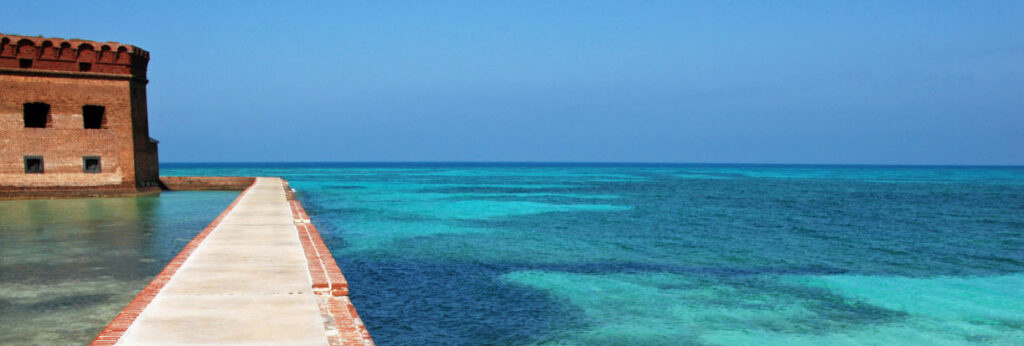
5. The Spiegel Grove Wreck
The Spiegel Grove Wreck in Key Largo is an iconic dive site known for its impressive size and complex structure. Originally a U.S. Navy Landing Ship Dock (LSD-32), the Spiegel Grove was intentionally sunk in 2002 to create an artificial reef where at 510 feet in length, it’s one of the largest ships ever scuttled for this purpose.
The wreck lies in the Florida Keys National Marine Sanctuary and has since become a thriving habitat for marine life, as well as a world-renowned dive site. It offers a unique and exhilarating experience for divers, combining the thrill of wreck exploration with the beauty of marine ecology.
Outline for Scuba Divers:
Access to Spiegel Grove Wreck:
- Location: Off Key Largo in the Florida Keys.
- Entry: Accessible by boat. Numerous dive operators in Key Largo offer charters to the site.
- Facilities: Key Largo provides full-service dive centers for equipment, air fills and guided tours.
Diving Conditions:
- Visibility: Generally good, ranging from 50 to 80 feet, depending on weather conditions.
- Water Temperature: Averages between 70-85 degrees Fahrenheit throughout the year.
- Dive Types: Primarily boat diving. Suitable for advanced divers due to the depth and complexity of the wreck.
- Depth: The top of the wreck starts at about 60 feet, with the sea floor at around 130 feet.
Marine Life and Features:
- Coral Growth: The wreck has developed into an artificial reef, with significant coral growth and sponges.
- Fish and Marine Creatures: Home to a variety of marine life including barracudas, groupers and schools of tropical fish. Occasional sightings of larger species like sharks and rays.
- Wreck Exploration: Offers a fascinating exploration experience with its large deck, cranes and cargo holds. Penetration diving is possible for trained wreck divers.
- Photography Opportunities: The size of the wreck and the abundance of marine life make it an excellent site for underwater photography.
Safety and Regulations:
- Dive Certification: Advanced Open Water certification or equivalent is recommended due to the depth and potential for strong currents.
- Buddy System: Diving with a buddy or as part of a guided group is advised for safety.
- Navigation Skills: Good navigation skills are essential due to the size and complexity of the wreck.
Additional Activities:
- Night Diving: Some operators offer night dives on the Spiegel Grove for a different perspective on the wreck.
The Spiegel Grove Wreck is a must-visit site for advanced divers in the Florida Keys that offers a unique blend of wreck exploration and natural reef diving. The site’s complexity and size make it a fascinating destination for multiple dives, with each visit revealing something new amidst its vast underwater landscape.
Check out these: 5 Tips for Flying with Scuba Gear
6. Fort Jefferson Wrecks
Fort Jefferson Wrecks, located off the coast of Pensacola, present a unique and historically rich diving experience. This area, known for its significant naval history, is home to a collection of shipwrecks that date back to various periods, offering a glimpse into the past.
These wrecks, scattered around the Gulf of Mexico near the Dry Tortugas National Park, not only serve as fascinating historical artifacts but have also become thriving artificial reefs, supporting a diverse array of marine life. Diving in this area is like exploring a living museum, where each wreck tells a story and contributes to the rich tapestry of underwater life.
Outline for Scuba Divers:
Access to Fort Jefferson Wrecks:
- Location: Off the coast of Pensacola, near Dry Tortugas National Park.
- Entry: Accessible primarily by boat. Dive charters are available from Key West and other locations in the Florida Keys.
- Facilities: Limited facilities due to the remote nature of the location. Key West offers full-service dive shops for equipment and trip arrangements.
Diving Conditions:
- Visibility: Generally good, often ranging from 50 to 100 feet, depending on weather conditions.
- Water Temperature: Averages between 70-85 degrees Fahrenheit, varying with the seasons.
- Dive Types: Primarily boat diving. Suitable for intermediate to advanced divers due to depth and potential currents.
- Depth: Varies among the different wrecks, with some lying in deeper waters.
Marine Life and Features:
- Coral Growth: Many of the wrecks have substantial coral growth, providing habitat for marine life.
- Fish and Marine Creatures: Diverse marine life including snappers, groupers, barracudas and occasionally larger species such as sharks.
- Historical Wrecks: The wrecks offer a unique historical perspective with some dating back to the 19th century.
- Exploration Opportunities: Divers can explore various features of the wrecks including decks, hulls and surrounding reef structures.
Safety and Regulations:
- Dive Certification: Advanced certification is recommended due to the depth and complexity of some wrecks.
- Navigation Skills: Good navigation skills are beneficial for exploring the larger wrecks.
- Environmental Awareness: Divers are encouraged to respect the wrecks as historical sites and avoid disturbing them.
Additional Activities:
- Photography: The wrecks and marine life offer excellent opportunities for underwater photography.
- Historical Exploration: Visiting Fort Jefferson on Garden Key provides additional historical context to the area.
Diving at the Fort Jefferson Wrecks off the coast of Pensacola offers a unique combination of historical exploration and natural beauty. The wrecks serve as a window into the past and a haven for marine life, making them a must-visit for divers interested in history and ecology alike.

7. The Cayman Salvager Wreck
The Cayman Salvager Wreck, located near Key West, is a renowned dive site that attracts scuba enthusiasts from around the world. This wreck is the remains of a 180-foot steel-hulled buoy tender, which sank in 1985 and has since transformed into an artificial reef, teeming with marine life and offering a fascinating exploration opportunity for divers.
The wreck’s relatively shallow depth makes it accessible to a wide range of divers, from intermediate to advanced, and its location in the clear waters of the Florida Keys provides excellent diving conditions.
Outline for Scuba Divers:
Access to Cayman Salvager Wreck:
- Location: Near Key West, in the Florida Keys.
- Entry: Accessible by boat. Numerous dive charters in Key West offer trips to the wreck.
- Facilities: Key West has a variety of dive shops for equipment rental, air fills and guided tours.
Diving Conditions:
- Visibility: Generally good, often ranging from 50 to 70 feet, providing clear views of the wreck.
- Water Temperature: Averages between 70-85 degrees Fahrenheit, comfortable for most divers.
- Dive Types: Primarily boat diving. Suitable for intermediate and advanced divers.
- Depth: The wreck lies in about 90 feet of water, with the top of the structure at around 60 feet.
Marine Life and Features:
- Coral Growth: The wreck has a healthy growth of corals and sponges, providing habitat for various marine species.
- Fish and Marine Creatures: Home to a diverse array of marine life, including schools of tropical fish, barracudas and occasionally larger species like sharks and rays.
- Wreck Exploration: The Cayman Salvager offers a compelling exploration experience with its large structure and open areas for penetration diving.
- Photography Opportunities: The wreck and its marine inhabitants present excellent subjects for underwater photography.
Safety and Regulations:
- Dive Certification: Suitable for divers with an Open Water certification, but Advanced Open Water certification is recommended due to the depth.
- Buddy System: Diving with a buddy or as part of a guided group is advised for safety.
- Navigation Skills: Good navigation skills are beneficial for exploring the wreck.
Additional Activities:
- Night Diving: Some operators offer night dives on the Cayman Salvager, providing a different perspective and experience.
The Cayman Salvager Wreck is a captivating dive site that offers a blend of historical intrigue and natural beauty. The wreck’s transformation into an artificial reef has created a vibrant ecosystem, making it a must-visit location for divers interested in wreck exploration and marine life observation.
Book your trip to Florida here!
8. Eagle’s Nest Sinkhole
Eagle’s Nest Sinkhole, located near Marianna, is an awe-inspiring and challenging dive site, often referred to as the “Mount Everest” of cave diving. This sinkhole is renowned for its deep, crystal-clear waters and intricate network of underwater caves and passages.
The site, hidden in a remote forest area, offers a unique and exhilarating experience for highly skilled and trained cave divers. The complexity and depth of Eagle’s Nest make it a site of particular interest and respect within the diving community, offering a blend of stunning natural beauty and significant technical challenge.
Outline for Scuba Divers:
Access to Eagle’s Nest Sinkhole:
- Location: Near Marianna, Florida.
- Entry: Access is through a remote forest area, requiring a hike with gear. The site is on private property, and permission is required for access.
- Facilities: Very limited facilities due to the remote location. Divers should be self-sufficient and plan accordingly.
Diving Conditions:
- Visibility: Exceptionally clear, often exceeding 100 feet, providing a surreal diving experience.
- Water Temperature: Consistently cool, around 70 degrees Fahrenheit year-round.
- Dive Types: Strictly for cave diving. Not suitable for open water divers or beginners.
- Depth: The sinkhole is extremely deep, with some passages going beyond 300 feet.
Marine Life and Features:
- Cave System: Intricate and extensive underwater cave system with large rooms and tight passages.
- Marine Life: Limited marine life due to the cave environment, but some freshwater species may be encountered.
- Geological Features: Stunning geological formations including stalactites and stalagmites.
Safety and Regulations:
- Dive Certification: Only for divers with advanced cave diving certification and experience.
- Equipment: Requires specialized cave diving equipment and redundant safety systems.
- Buddy System: Mandatory to dive with a buddy or team, given the site’s complexity and potential risks.
- Emergency Procedures: Divers should have a well-planned dive with clear emergency procedures due to the remote location and depth.
Additional Considerations:
- Environmental Impact: Divers are urged to minimize their impact on the delicate cave environment.
- Physical Fitness: High level of physical fitness and technical skill required.
Eagle’s Nest Sinkhole is a site that commands respect and preparation due to its depth, complexity and potential hazards however offers an unparalleled experience for the few who are qualified to explore its depths. The clarity of the water and the intricate cave formations make it a memorable dive for those with the skill and experience to safely navigate its challenges.

9. Vortex Springs
Vortex Springs, located near Ponce de Leon, is a popular freshwater dive site known for its crystal-clear waters and serene underwater environment. This spring is a haven for divers and snorkelers of all skill levels, offering a controlled environment that’s ideal for both training and recreational diving.
The spring is part of a privately-owned recreation area and is one of the largest diving facilities in the state, featuring a variety of underwater formations and an abundance of freshwater marine life. Its accessibility and consistent conditions make Vortex Springs an excellent year-round diving destination.
Outline for Scuba Divers:
Access to Vortex Springs:
- Location: Near Ponce de Leon, Florida.
- Entry: Accessible through the Vortex Springs recreational facility, which charges an entry fee.
- Facilities: The site offers amenities such as gear rental, air fills, lodging and camping facilities, making it suitable for extended stays.
Diving Conditions:
- Visibility: The water is exceptionally clear, with visibility often exceeding 100 feet.
- Water Temperature: A consistent 68 degrees Fahrenheit year-round, ideal for comfortable diving.
- Dive Types: Suitable for divers of all levels, from beginners to advanced cave divers.
- Depth: The spring basin has a depth of about 50 feet, while the cave system extends much deeper for trained cave divers.
Marine Life and Features:
- Aquatic Life: Home to a variety of freshwater fish and turtles.
- Underwater Terrain: Features include a large open basin, underwater platforms for training and a cavern that leads to a more extensive cave system.
- Cave Diving: The cave system is accessible only to certified cave divers and extends over 1,600 feet at depths up to 115 feet.
Safety and Regulations:
- Dive Certification: Open to all certified divers; cave diving areas are restricted to those with appropriate cave diving certifications.
- Training Opportunities: Popular site for dive training and certification courses due to controlled conditions.
- Rules and Guidelines: Divers must adhere to the safety rules and guidelines provided by the facility.
Additional Activities:
- Snorkeling and Swimming: The clear, shallow areas are also popular for snorkeling and swimming.
- Recreational Facilities: The park offers other recreational activities like zip-lining and swimming in the spring.
Vortex Springs is an ideal destination for divers and snorkelers looking for a safe and controlled environment. Its clear waters and diverse underwater features offer a unique experience for training and exploration. The facility’s comprehensive amenities make it a convenient and enjoyable location for both day trips and longer diving excursions as well.
10. Ginnie Springs
Ginnie Springs, located near High Springs, is a celebrated freshwater spring and a premier destination for scuba divers. Renowned for its crystal-clear waters and serene underwater environment, Ginnie Springs offers a unique diving experience distinct from the oceanic dives typically associated with Florida.
This spring is not only a popular spot for recreational swimming and tubing but also a haven for scuba divers seeking to explore its underwater beauty.
Outline for Scuba Divers:
Access to Ginnie Springs:
- Location: Near High Springs, Florida.
- Entry: Accessible through the Ginnie Springs Outdoors private park.
- Facilities: The park provides amenities such as parking, a dive shop for equipment rental, air fills and camping facilities.
Diving Conditions:
- Visibility: Exceptionally clear, often exceeding 100 feet, making it ideal for underwater photography.
- Water Temperature: Consistently around 72-75 degrees Fahrenheit year-round, comfortable for diving with appropriate wetsuits.
- Dive Types: Suitable for both open water dives and cave diving for certified divers.
- Depth: Varies across different parts of the spring, with some areas suitable for beginners and others more suited for experienced divers.
Marine Life and Features:
- Aquatic Life: Home to a variety of freshwater fish such as bluegill sunfish, largemouth bass and garfish. Divers may also encounter turtles.
- Underwater Landscape: Features an enchanting underwater landscape with rocky caverns and lush aquatic vegetation.
- Cave Systems: For trained cave divers, Ginnie Springs offers an extensive network of underwater caves to explore.
- Photography Opportunities: The clarity of the water and the abundance of sunlight make it an excellent location for underwater photography.
Safety and Regulations:
- Dive Certification: Divers need to be certified, and those wishing to explore the caves must have cave diving certification.
- Buddy System: Diving with a buddy is recommended for safety.
- Preservation: Divers are encouraged to respect and preserve the natural underwater environment.
Ginnie Springs provides a serene and visually stunning diving experience, making it a must-visit location for scuba enthusiasts. Its combination of clear waters, diverse marine life, and unique underwater landscape not found in many other locations.

11. Devil’s Den
Devil’s Den, located near Williston, is a prehistoric natural wonder and a unique diving destination. This underground spring inside a dry cave has been attracting visitors for thousands of years, including early Native Americans and today, it’s renowned among scuba divers and snorkelers for its stunning geological formations and crystal-clear waters.
The cave’s roof collapsed thousands of years ago, creating a natural skylight that illuminates the clear spring water below. Diving in Devil’s Den is like stepping back in time, offering a serene and otherworldly experience unlike any other dive site.
Outline for Scuba Divers:
Access to Devil’s Den:
- Location: Near Williston, Florida.
- Entry: Accessible through the Devil’s Den Spring private facility, which charges an entry fee.
- Facilities: The site offers amenities such as gear rental, air fills, and lodging options like cabins and camping.
Diving Conditions:
- Visibility: Exceptionally clear, often exceeding 100 feet, providing a surreal underwater experience.
- Water Temperature: A consistent 72 degrees Fahrenheit year-round, ideal for comfortable diving.
- Dive Types: Suitable for open water divers. The site is popular for both scuba diving and snorkeling.
- Depth: The water depth reaches up to 54 feet, with the cave system extending deeper for certified cave divers.
Marine Life and Features:
- Aquatic Life: Limited marine life, as it’s a freshwater spring, but divers might encounter small fish and turtles.
- Geological Features: Impressive rock formations, ancient fossil beds and the unique skylight opening at the top of the cave.
- Cave Diving: The cave system is accessible only to divers with appropriate cave diving certifications.
Safety and Regulations:
- Dive Certification: Open to all certified divers; cave areas are restricted to those with cave diving certifications.
- Preservation: Divers are encouraged to respect the delicate cave environment and adhere to no-touch rules.
Additional Considerations:
- Photography: The natural light from the skylight creates a unique environment for underwater photography.
- Physical Fitness: Divers should be comfortable in enclosed spaces and have good buoyancy control.
Devil’s Den offers a unique and tranquil diving experience, set within a stunning geological backdrop. Its clear waters and fascinating cave formations make it a memorable destination for divers and snorkelers alike and the facility’s amenities and controlled environment make it an accessible and enjoyable location for a range of underwater adventures.
Book your trip to Florida here!
12. Blue Grotto
Blue Grotto, situated near Williston, is a renowned freshwater dive site that offers a unique and enchanting underwater experience. This large, clear-water cavern is one of the largest in the state and is known for its stunning clarity and depth, providing a safe and beautiful environment for both training and recreational diving.
A distinctive feature of Blue Grotto is the presence of an air bell at about 30 feet below the surface, allowing divers to surface and talk underwater. This dive site, with its serene and mystical ambiance, is a must-visit for anyone interested in exploring the underwater world of Florida’s springs.
Outline for Scuba Divers:
Access to Blue Grotto:
- Location: Near Williston, Florida.
- Entry: Accessible through a dive center that manages the site, with an entry fee for divers.
- Facilities: The site offers amenities like gear rental, air fills, and a dive shop. There are also facilities for training and certification courses.
Diving Conditions:
- Visibility: Exceptionally clear, often exceeding 100 feet, ideal for training and exploration.
- Water Temperature: A consistent 72 degrees Fahrenheit year-round, comfortable for most divers.
- Dive Types: Suitable for divers of all skill levels, from beginners to advanced.
- Depth: The cavern extends down to about 100 feet, with the main cavern area suitable for less experienced divers.
Marine Life and Features:
- Aquatic Life: Limited to typical freshwater species like small fish and turtles.
- Underwater Features: The cavern’s main feature is the air bell, a unique spot where divers can surface and talk.
- Geological Formations: Stunning rock formations and clear waters offer a visually captivating dive.
Safety and Regulations:
- Dive Certification: Open to all certified divers. The deeper parts of the cavern are restricted to those with appropriate training.
- Guided Dives: Available for less experienced divers or those unfamiliar with cavern diving.
- Preservation: Divers are encouraged to respect the natural environment and adhere to conservation practices.
Additional Activities:
- Training and Certification: The controlled conditions make Blue Grotto ideal for dive training and certification courses.
- Photography: The clarity of the water and the unique features of the cavern provide excellent opportunities for underwater photography.
Blue Grotto offers a serene and otherworldly diving experience, making it a popular destination for both recreational and training purposes where its clear waters, fascinating underwater features, and the novelty of the air bell create an unforgettable diving adventure. The facility’s comprehensive amenities and the site’s natural beauty make it a top choice for divers exploring the freshwater springs of Florida.
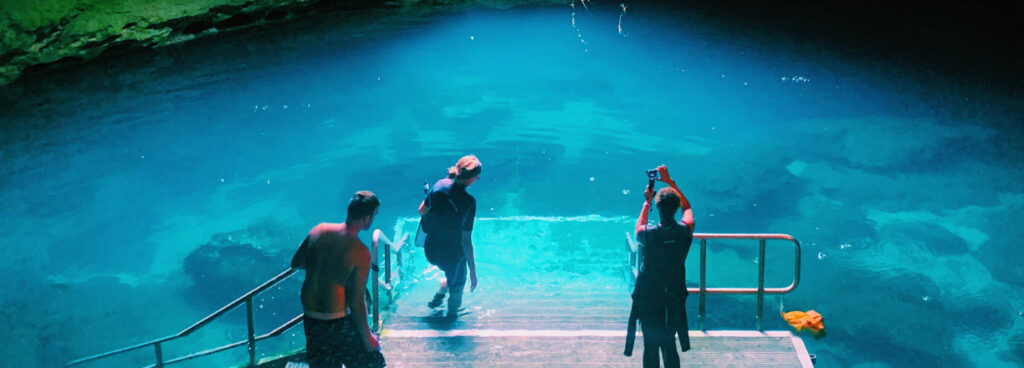
Diving Conditions in Florida
Florida offers a unique diving experience with its varied underwater environments. You’ll navigate through waters offering diverse levels of visibility and come across rich marine habitats teeming with life.
Visibility and Currents
Visibility:
- Freshwater Springs: Exceptional clarity, often exceeding 200 feet.
- Ocean Sites: Ranges from 50 to 100 feet, conditions may vary.
Currents:
- Gulf Stream Influence: Stronger currents, particularly in the Atlantic.
- Inland Sites: Gentle to negligible flow, ideal for newcomers.
Marine Life and Habitats
Marine Life:
- Encounter species like eagle rays and spiny lobsters.
- Spot a variety of tropical fish among the coral reefs.
Habitats:
- Reefs: Found near coastal areas, supporting coral and sponges.
- Wrecks: Serving as artificial reefs attracting diverse marine life.
Scuba Certification and Training in Florida
Before you can explore the underwater wonders of Florida, you need to become certified. A range of certifications can prepare you for the diverse dive sites, and selecting a reputable dive school is crucial for your training.
Certification Options
PADI, SSI, and NAUI are among the major certification agencies you’ll encounter in Florida. Here’s what you need to know:
- PADI: Offers comprehensive courses ranging from beginner Open Water Diver to more advanced specialties.
- SSI: Provides personalized training and recognizes logged diving experience.
- NAUI: Known for emphasizing dive safety through education.
The types of courses offered typically include:
- Open Water Diver: Your ticket to dive anywhere in the world.
- Advanced Open Water Diver: Enhances skills and allows deeper diving.
- Rescue Diver: Focuses on problem prevention and management.
- Specialty Courses: Such as wreck diving, night diving, or underwater photography.
Choosing a Dive School
When determining where to get certified, consider the following:
- Location: Proximity to diverse diving locations for practice.
- Facilities: Quality of the pools, classrooms and rental gear.
- Instructors: Look for experienced individuals with positive reviews.
- Accreditations: Schools should be recognized by major diving agencies.
Checklist for Choosing a Dive School:
- Accredited by PADI, SSI, NAUI, or similar
- Access to quality dive sites for training
- Qualified and experienced instructors
- Modern and well-maintained equipment
- Positive reviews and testimonials
FAQs
For beginners, what are the ideal scuba diving spots in Florida?
Blue Heron Bridge in Palm Beach County is an excellent spot for beginners due to its shallow waters and plentiful marine life. Another great location is the shallow reefs off Key West, which allow novice divers to comfortably observe the diverse ecosystems without deep diving.
Conclusion
There you have it, 12 best scuba diving spots in Florida. As usual, let me know of your experiences here or if there is anywhere you think I need to add.
Also, please do not hesitate to comment below if you have any questions, concerns, or corrections or would like me to check anything else out for you.
Until next time.
Have fun
Paul


